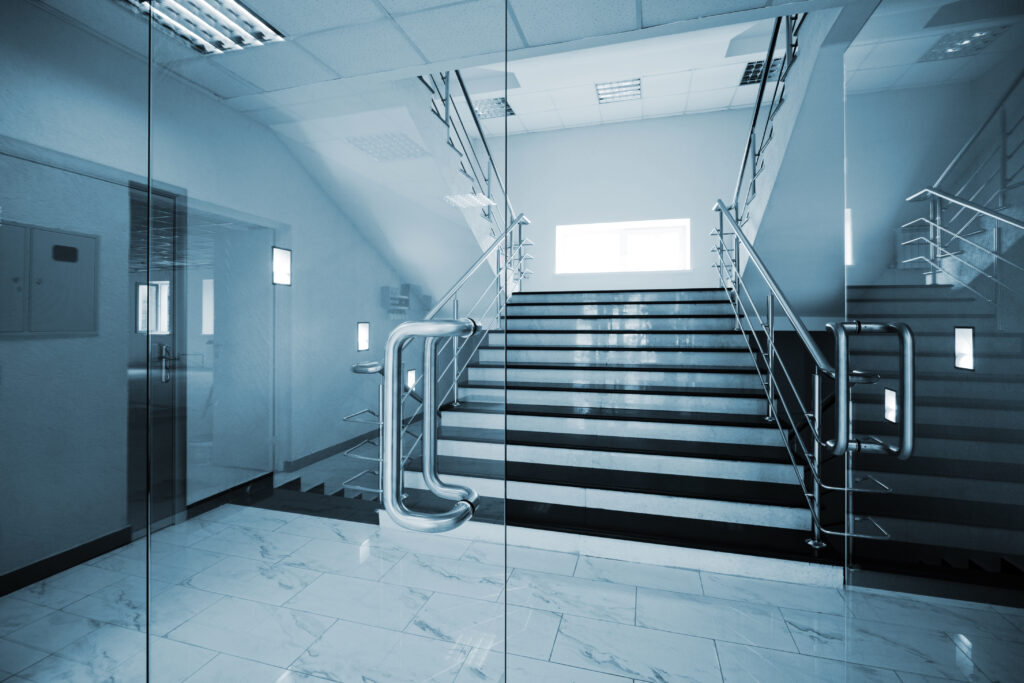Choosing the right glass security door for a commercial or public building is a critical decision that impacts both safety and design. These doors serve as the first line of defense against threats while also contributing to a building’s overall aesthetic and functionality.

Beyond their sleek appearance, glass security doors are engineered for strength and durability, offering protection against forced entry, ballistic threats, and environmental factors. Whether for a bank, school, retail space, or government facility, selecting the right security door requires careful consideration of materials, glazing options, and customization features.
Below, we explore the benefits and applications for glass security doors, along with Insulgard’s industry-leading solutions designed to meet your facility’s unique security needs.
Benefits and Advantages of a Glass Security Door
A glass security door provides the best of both worlds—clear visibility and reinforced protection. They can be used for both interior and exterior applications and are available in various sizes and styles. What defines them as “security” doors is their reinforced or laminated construction, which is designed and tested to withstand impact or even ballistic force. This helps protect building occupants and valuable assets from potential intrusions.
Protection Against Forced Entry and Ballistic Threats
Security glass doors are engineered to resist break-ins and delay intruders, helping law enforcement or security teams respond in time.
- Some doors use laminated glass, which incorporates a synthetic interlayer to hold glass pieces together after impact, preventing immediate failure.
- Others feature polycarbonate or acrylic layers, which absorb impact better than standard glass.
Polycarbonate and acrylic doors are typically used for interior applications, while laminated glass and glass-clad polycarbonate are preferred for exterior security doors.
Visibility, Natural Light & Modern Design
Glass security doors provide clear sightlines, helping staff monitor entry points and identify potential threats before they become an issue.
Additionally, these doors allow natural light to flow into interior spaces, creating a more welcoming and open environment while reducing the need for artificial lighting.
Options for A Glass Security Door
To ensure a glass security door functions effectively for your facility, it may need to be customized.
Sizing & Retrofitting Considerations
For new construction and existing buildings, architects and engineers often require precise sizing options to match specific spatial layouts.
Design & Aesthetic Customization
Glass security doors can be tailored to match various architectural styles. Some doors offer full visual clarity with little to no opaque framing, while others may incorporate some decorative framing elements. Popular frame colors & finishes include:
- Black – Modern and sleek.
- Dark bronze – Classic and professional.
- Woodgrain – Warm and natural.
- Exposed metal – Industrial and high-tech.
For example, a building with historic exterior features may require traditional bronze framing to match the surrounding neighborhood, while a modern facility may opt for sleek aluminum finishes.
Additional Security & Access Control Features
Security glass doors can also be enhanced with functional features, including:
- Speaker ports or pass-through trays for secure transactions.
- Electrified hardware with card readers for controlled access.
- Remote locking mechanisms for restricted areas.
- Multiple access control systems for high-security areas, such as employee safe rooms.
Interior vs. Exterior Considerations
The choice of materials and framing design may vary depending on whether the door is used indoors or outdoors.
- Exterior glass security doors often feature aluminum frames as well as door rails and stiles to provide better weather ability and higher levels of security.
- Interior doors may incorporate frameless doors or wood lamination for aesthetic reasons.
Comparing Glass Security Doors to Other Security Door Options
Glass security doors provide a unique combination of strength, transparency, and modern aesthetics, making them an excellent choice for many facilities. However, depending on security needs, other types of security doors may be considered as well.
Hollow metal doors are often used in high-security environments such as prisons, police stations, and military facilities. These doors are known for their extreme durability and fire resistance, making them ideal for areas that require maximum protection. However, they lack the visibility and aesthetic appeal of glass security doors, which can make a facility feel more open and accessible.
For a more traditional look, wood core security doors provide both security and design versatility. These doors are often used in government offices, high-end retail stores, and historic buildings where maintaining a classic appearance is important. While wood core doors can be manufactured with ballistic-resistant materials, they do not provide the same level of visibility as glass security doors.
Another alternative is polycarbonate security doors, which offer a lightweight yet impact-resistant solution. These doors are commonly used in interior security partitions and controlled-access areas. While polycarbonate doors are strong and shatter-resistant, they may not provide the same level of durability as metal-framed glass security doors when exposed to harsh weather conditions or long-term heavy use.
Ultimately, choosing the right security door depends on the balance between protection, aesthetics, and functionality.
Insulgard’s Glass Security Doors & Glazing Solutions
Bullet-Resistant Doors
Insulgard offers a variety of BULLETBLOCK® bullet-resistant doors, tested to UL 752 ballistic standards, that incorporate clear glass elements for visibility and protection:
- 44/350 Aluminum Door System (UL 752 Level 1-3) – Available with full or half vision glazing, allowing for enhanced visibility while maintaining ballistic protection.
- HP500 Aluminum Door System (UL 752 Levels 5 & 8) – Designed with full vision glazing, offering high-level ballistic resistance while maintaining a clear view.
- Polymer Door System (UL 752 Level 1-3) – Made from transparent polycarbonate, or acrylic providing a lightweight yet impact-resistant security solution.
Bullet-Resistant Glass for Doors
For doors requiring custom security glazing, Insulgard provides:
- Acrylic Glazing – Impact-resistant and lightweight.
- Laminated Polycarbonate – Secure and highly transparent.
- Glass-Clad Polycarbonate – UL Levels 1-8 bullet-resistant glazing.
- All-Glass Laminate – Optical clarity with durability.
If your facility requires a glass security door or other protective solutions, Insulgard Security Products can help. Contact our experts today or request a quote.

